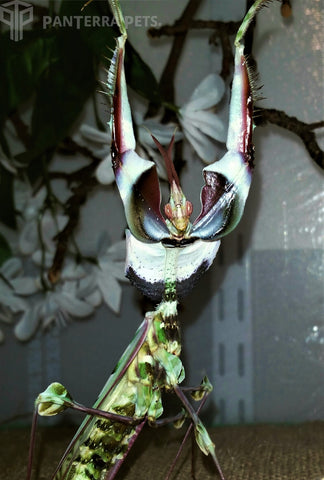Giant Devil's Flower Mantis Caresheet
Housing
The Giant Devil's Flower Mantis (Idolomantis diabolica) should be kept in an enclosure that is at least 3 times as tall as the mantis is long, and at least 2 times as wide as the mantis is long. Females can get up to 5 inches long as adults, while males get around 4 inches long. The cage must also have extra heat, adequate ventilation, and some kind of material on the ceiling of the enclosure which they can grip well, as well as an empty space at the top which is at least 2 times the size of the mantis. This allows the mantis to hang upside down during molting, and safely make it out of their old exuvia.
Because Devil's Flower mantises are Empusids, they cannot climb smooth surfaces and should be kept in mesh or screen cages with plenty of sticks on which to climb. And, because of their complex and heavy bodies, many people take extra precautions with this species, by adding additional gripping material to the sides and top of the enclosure, such as burlap or shelf-liner, to make sure they always have the appropriate material to grip onto with the hooks on their feet when it is time to molt. For this reason, living vivariums are not a practical option for them. They should be given a simple enclosure with fake plants and lots of branches on which to climb. You could even add a live, potted plant in the cage, but definitely skip the fully planted terrarium setup for these guys.
 Temperature & Humidity
Temperature & Humidity
Devil's Flower mantises need heat but also humidity, which causes an additional challenge when raising them. The ideal temperature for them is 95F, but they can be safely kept between 85°F and 104°F, and should have at least 40% to 50% relative humidity (RH) at all times. Please note, this is a "minimum" requirement, and they will actually benefit from higher humidity levels, especially as they get larger and more bulky, to aid in molting. A reptile heat lamp or a ceramic heat emitter will satisfy their temperature requirements, though even a 40 or 60-watt incandescent bulb in a desk lamp at closer range may provide enough heat depending on the surrounding environment. Just be sure to keep any heat lamp or desk lamp a suitable distance from the enclosure to avoid overheating or fire hazards.
The enclosure should be misted at least once a day so they can drink. When kept in mesh or screen cages, we mist their enclosures twice a day. Since this species requires a heat lamp, humidity can drop extremely low very quickly in the enclosure, without misting multiple times a day. Due to the challenge of keeping heat and humidity up at the same time, additional modifications to their enclosure may be required to ensure adequate ventilation as well as humidity for them. Low humidity can result in a mismolt, but even with suitably higher humidity, molting for this species can be difficult.
Most mantises do not like getting sprayed directly, so it is best to try and spray around the mantis, but if you get them a little wet by accident, it is usually no big deal. Use spring water, distilled water, or water filtered by reverse osmosis (RO), but do not use plain tap water.
Feeding
The Devil's Flower mantis should be fed flying prey throughout their entire lives, as they will not chase after food at all! They only eat when something flies right by them, grabbing the fly right out of midair! Most tend to completely ignore crickets and other crawling prey, unless the prey insect crawls right by them and they are VERY hungry. These mantises can be fed only blue bottle flies throughout their entire adult lives and remain perfectly healthy and happy.
- L1 nymphs: Should be fed D. melanogaster fruit flies.
- L2 and L3 nymphs: Should be fed D. hydei fruit flies.
- L4 and L5 nymphs: Should be fed house flies, or blue bottle flies.
- L6 nymph to adult: Should be fed blue bottle flies.
Devil's Flowers should be fed every day or every other day. They eat a lot, therefore, it is not a good idea to wait too long between feedings. It seems that no matter how many flies we put in their enclosure in the morning before work, they are almost all gone by the evening when we get home!

 Temperature & Humidity
Temperature & Humidity